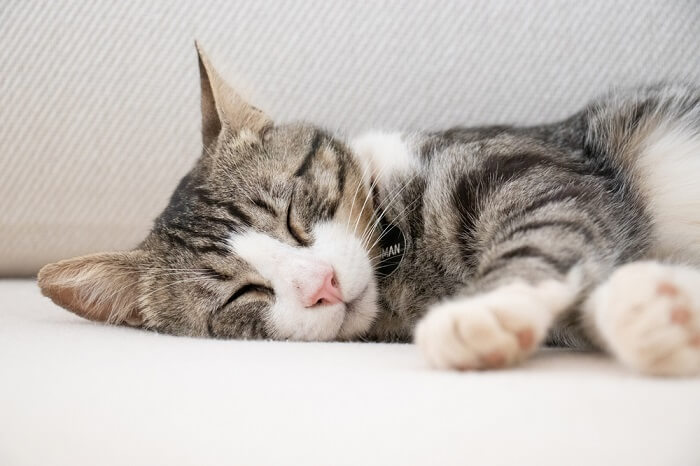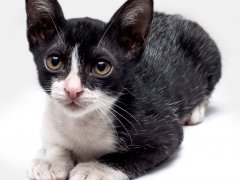
Cats are very good at hiding signs that they are stressed. The reason for this is because the domestic house cat evolved from the African wildcat, which was both a predator to small animals and prey to large animals, and showing signs of stress or pain would make the cat seem like an easy target to predators.
Some stress is to be expected, but chronic stress in cats, however, can lead to behavioral and even medical problems, which is why it is important to know if your cat is stressed, know what is stressing your cat out, and how to resolve the problem.
How Do I Know if My Cat Is Stressed?
Cats manifest the signs of stress in a variety ways, including behavioral problems and physical symptoms.
Physical symptoms can include:
- Litterbox issues, either going outside the litterbox, not going to the litterbox as often resulting in constipation, squatting for a longer time in the litterbox without producing urine, producing bloody urine, vocalizing while urination, or running away from the litterbox after using it
- Overgrooming, resulting in bald patches or rashes
- Worsening of symptoms in cats with chronic health problems, such as upper respiratory viruses
- Eating more or less than usual
- Eating things they shouldn’t
- Diarrhea and/or vomiting
- Excessive sleeping
- Changes in weight
- Ears are flattened or rotated backward much of the time
- Rippling or twitching skin down the back, especially after petting
Also Read: Cat Symptoms Checker
Behavioral problems associated with stress include:
- Urine spraying or marking
- Acting aggressive behavior toward you, other people, or other pets in the household
- Hiding more or alternatively, more clingy
- Excessive vocalization, including meowing, growling, and hissing
- Acts jumpy, dilated eyes, tense hunched position, fur is puffed out
- Less interest in play
- Pacing
What Causes Stress in Cats?

There are many factors that can cause stress in cats and moving, renovating, getting new furniture or moving furniture are some of them.
There are many things that can cause stress in cats. Cats like routine. They like to know what to expect, and they definitely don’t like surprises. Most stress in cats is caused by changes in routine, strange cats wandering into their territory, a lack of resources, sickness, boredom, pain, and lack of socialization.
In specific, sources of stress can include:
- A dirty litterbox, moving the litterbox, changing the litter, changing the tray, too many cats in one box
- Moving, renovating, getting new furniture or moving furniture
- Changing food abruptly
- Stray cats in the neighborhood, conflict with a cat in the household, adding a new pet to the household, being bullied by another cat, mirrors (which look like another cat)
- Boredom
- Pain, often dental or arthritis pain
- Veterinary visits, boarding
- Human visitors or new people in the house, new baby, children
- Lack of socialization when cat was a kitten
- Heavy scents (candles, detergents, etc.)
- Lack of resources for all the cats (bedding, bowls, etc.)
- Lack of scratching opportunities
How To Reduce Stress for Cats

One of the ways to help your cat lower the levels of stress is by providing it with scratching opportunities.
There are a couple of main points when it comes to reducing stress in cats:
- Establish a routine and stick to it. Avoid sudden changes in your cat’s life, instead, make changes gradually.
- Remove or reduce stressors (such as strange cats, mirrors, etc.) as possible.
- Provide environmental enrichment through increased climbing and vertical space opportunities, food puzzles, scratching opportunities, and daily play sessions.
- Maintain daily excellent litterbox hygiene, use basic boxes, get rid of liners and hoods and don’t use harsh chemicals that irritate your cat’s boopable snoot.
- Provide resources for every cat (litterbox, food and water bowls, beds, resting places, toys, etc.). Experts recommend having one more litterbox than the number of cats.
- Avoid using heavy scents in the home (candles, essential oils, scented detergents, etc.)
- Make sure you have adequate space for the number of cats you have: ASPCA recommends 18 square feet per cat.
- Provide adequate socialization to kittens: San Diego Humane has a great checklist on how to do this.
- Utilize calming aids as necessary. This includings pheromone sprays, thundershirt, anxiety medication, calming treats, Assisi loop, etc.
- Partner with your veterinarian to make sure your cat is in good health and free of pain.
- Visit Fear Free Happy Homes for tips on how to make veterinary visits less stressful, and more tips on reducing fear and anxiety in cats.








Excellent resource.